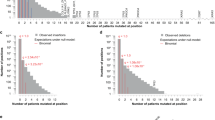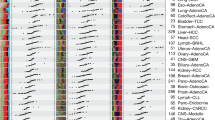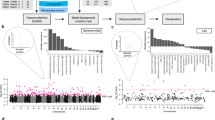Abstract
Although a few cancer genes are mutated in a high proportion of tumours of a given type (>20%), most are mutated at intermediate frequencies (2–20%). To explore the feasibility of creating a comprehensive catalogue of cancer genes, we analysed somatic point mutations in exome sequences from 4,742 human cancers and their matched normal-tissue samples across 21 cancer types. We found that large-scale genomic analysis can identify nearly all known cancer genes in these tumour types. Our analysis also identified 33 genes that were not previously known to be significantly mutated in cancer, including genes related to proliferation, apoptosis, genome stability, chromatin regulation, immune evasion, RNA processing and protein homeostasis. Down-sampling analysis indicates that larger sample sizes will reveal many more genes mutated at clinically important frequencies. We estimate that near-saturation may be achieved with 600–5,000 samples per tumour type, depending on background mutation frequency. The results may help to guide the next stage of cancer genomics.
This is a preview of subscription content, access via your institution
Access options
Subscribe to this journal
Receive 51 print issues and online access
$199.00 per year
only $3.90 per issue
Buy this article
- Purchase on SpringerLink
- Instant access to full article PDF
Prices may be subject to local taxes which are calculated during checkout





Similar content being viewed by others
Accession codes
Data deposits
The data analysed in this manuscript have been deposited in Synapse (http://www.synapse.org), accession number syn1729383, and in dbGaP (http://www.ncbi.nlm.nih.gov/gap), accession numbers phs000330.v1.p1, phs000348.v1.p1, phs000369.v1.p1, phs000370.v1.p1, phs000374.v1.p1, phs000435.v2.p1, phs000447.v1.p1, phs000450.v1.p1, phs000452.v1.p1, phs000467.v6.p1, phs000488.v1.p1, phs000504.v1.p1, phs000508.v1.p1, phs000579.v1.p1, phs000598.v1.p1.
References
Garraway, L. A. & Lander, E. S. Lessons from the cancer genome. Cell 153, 17–37 (2013)
Vogelstein, B. et al. Cancer genome landscapes. Science 339, 1546–1558 (2013)
Imielinski, M. et al. Mapping the hallmarks of lung adenocarcinoma with massively parallel sequencing. Cell 150, 1107–1120 (2012)
Carter, S. L. et al. Absolute quantification of somatic DNA alterations in human cancer. Nature Biotechnol. 30, 413–421 (2012)
Cibulskis, K. et al. Sensitive detection of somatic point mutations in impure and heterogeneous cancer samples. Nature Biotechnol. 31, 213–219 (2013)
Lawrence, M. S. et al. Mutational heterogeneity in cancer and the search for new cancer-associated genes. Nature 499, 214–218 (2013)
Zack, T. I. et al. Pan-cancer patterns of somatic copy number alteration. Nature Genet. 45, 1134–1140 (2013)
Lohr, J. G. et al. Discovery and prioritization of somatic mutations in diffuse large B-cell lymphoma (DLBCL) by whole-exome sequencing. Proc. Natl Acad. Sci. USA 109, 3879–3884 (2012)
Cancer Genome Atlas Research. Integrated genomic characterization of endometrial carcinoma. Nature 497, 67–73 (2013)
Kandoth, C. et al. Mutational landscape and significance across 12 major cancer types. Nature 502, 333–339 (2013)
Tamborero, D. et al. Comprehensive identification of mutational cancer driver genes across 12 tumor types. Sci. Rep. 3, 2650 (2013)
Hanahan, D. & Weinberg, R. A. Hallmarks of cancer: the next generation. Cell 144, 646–674 (2011)
Ferlay, J. et al. Estimates of worldwide burden of cancer in 2008: GLOBOCAN 2008. Int. J. Cancer 127, 2893–2917 (2010)
Acknowledgements
This work was conducted as part of TCGA, a project of the National Cancer Institute and the National Human Genome Research Institute. We are grateful to T. I. Zack, S. E. Schumacher, and R. Beroukhim for sharing their copy-number analyses before publication.
Author information
Authors and Affiliations
Contributions
G.G., E.S.L., T.R.G., M.M., L.A.G. and S.B.G. conceived the project and provided leadership. M.S.L., G.G., E.S.L., P.S. and C.H.M. analysed the data and contributed to scientific discussions. M.S.L., E.S.L. and G.G. wrote the paper. J.T.R., M.S.L., E.S.L. and G.G. created the website for visualizing this data set.
Corresponding authors
Ethics declarations
Competing interests
A patent related to this work has been filed.
Supplementary information
Supplementary Information
This file contains Supplementary Figures 1-9 and legends for Supplementary Tables 1-6 (see separate files for tables). (PDF 1511 kb)
Supplementary Table 1
This file contains a list of source datasets analyzed in this work, and references to the corresponding publications. (XLS 28 kb)
Supplementary Table 2
This file contains the 260 significantly mutated cancer genes found by analysis with the MutSig suite (see Supplementary Information file for full legend). (XLSX 709 kb)
Supplementary Table 3
This file contains a list of the 21 tumor types studied, and the significantly mutated genes found by the MutSig suite in each tumor type (see Supplementary Information file for full legend). (XLSX 16 kb)
Supplementary Table 4
The file contains a list of references reporting the identification of candidate cancer genes (see Supplementary Information file for full legend). (XLSX 58 kb)
Supplementary Table 5
This file contains a list of references to biological literature supporting the 33 novel candidate cancer genes with clear and compelling connections to cancer biology. (XLSX 21 kb)
Supplementary Table 6
This file contains a summary of the analysis comparing the performance of each of the three MutSig metrics separately, in pairwise combinations, and all three combined as in the main analysis (see Supplementary Information file for full legend). (XLS 24 kb)
Rights and permissions
About this article
Cite this article
Lawrence, M., Stojanov, P., Mermel, C. et al. Discovery and saturation analysis of cancer genes across 21 tumour types. Nature 505, 495–501 (2014). https://doi.org/10.1038/nature12912
Received:
Accepted:
Published:
Issue Date:
DOI: https://doi.org/10.1038/nature12912
This article is cited by
-
Functional characterization of cooperating MGA mutations in RUNX1::RUNX1T1 acute myeloid leukemia
Leukemia (2024)
-
Interplay of miR-542, miR-126, miR-143 and miR-26b with PI3K-Akt is a Diagnostic Signal and Putative Regulatory Target in HPV-Positive Cervical Cancer
Biochemical Genetics (2024)
-
NUDT21 interacts with NDUFS2 to activate the PI3K/AKT pathway and promotes pancreatic cancer pathogenesis
Journal of Cancer Research and Clinical Oncology (2024)
-
Comprehensive pan-cancer analysis reveals that C5orf34 regulates the proliferation and mortality of lung cancer
Functional & Integrative Genomics (2024)
-
Pan-cancer classification of multi-omics data based on machine learning models
Network Modeling Analysis in Health Informatics and Bioinformatics (2024)



